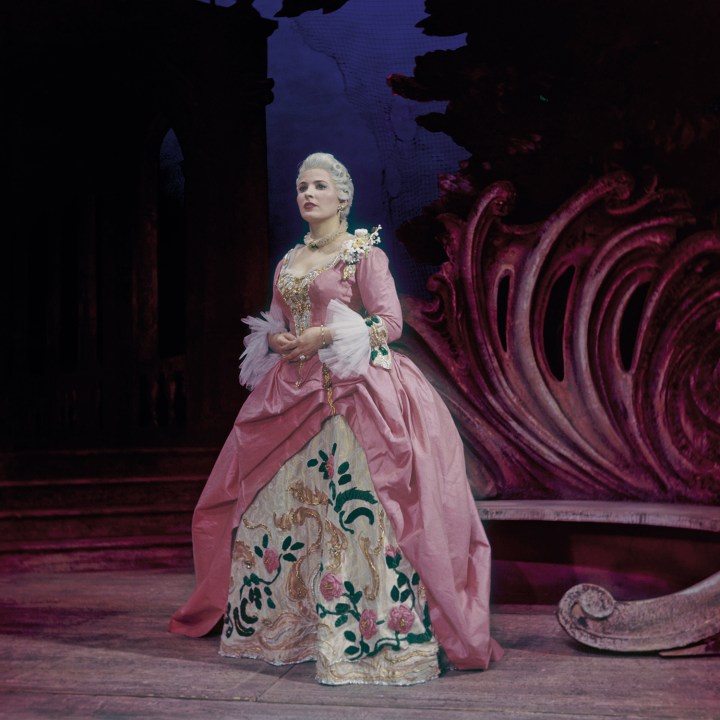
Through the grey downbeat years of postwar austerity, we nursed cheering fantasies of a life more lavishly colourful and hedonistic. Oliver Messel fed them: born into Edwardian privilege, the epitome of well-connected metropolitan sophistication, he doubled up as interior decorator and stage designer, creating in both roles a unique style of rococo elegance and light-touch whimsy that sweetened and consoled – ‘a gossamer world of gilded enchantment’ as Roy Strong soupily put it. ‘Marie Antoinette would have felt at home in any of his settings.’
Like his rival Cecil Beaton, Oliver Messel sums up an era
Posterity has not been kind to Messel. Only a little of his art has survived changes of fashion since his death in 1978: the Dorchester Hotel is currently restoring the VIP suite he dreamed up, and several villas in his beloved Barbados retain the appearance and atmosphere that he suavely devised for them. But aside from the Royal Ballet’s unsuccessful attempt to resuscitate the splendours of his 1946 vision of The Sleeping Beauty, the work he prolifically did for the stage, both in Britain and the USA, survives only in coffee-table books and the archives.
Perhaps the long lens of history will judge Messel’s most substantial theatrical achievement to be embodied in the nine operas by Strauss, Rossini and Mozart that he designed for Glyndebourne between 1950 and 1959. An expertly curated exhibition, running through the current festival’s season in the opera house’s foyer, pays these legendary productions handsome tribute.
Glyndebourne’s fête champêtre was Messel’s natural element, and his ancillary designs for the programme book and proscenium arch did much to establish what might now be described as its brand. Part of his genius was his understanding the village-hall scale of Glyndebourne’s stage. The palatial scenes of Idomeneo and Der Rosenkavalier had intimacy as well as spaciousness, while the servants’ quarters in Le nozze di Figaro and La Cenerentola were cutely cosy rather than dingy – Glyndebourne audiences in the 1950s weren’t in the mood for gritty realism, and Messel seduced them with a sumptuous yet subtle palette of pink, green, plum, turquoise, ultramarine and canary yellow.
Even if his initial sketches, dashed off in one session, were so impressionistic that seamstresses were hard put to interpret his intentions, he lavished as much imagination on costumes as he did on the scenery, relishing the textures of taffeta, chiffon and silk. Sadly few of these have been preserved, but a centrepiece of the exhibition is the Marschallin’s gorgeous midnight blue and salmon pink gown from Rosenkavalier, worn by two great sopranos, Régine Crespin and Montserrat Caballé. Props also engaged him: Messel may have drawn vaguely, but he was meticulous and resourceful in the atelier, hands on and dirty, making do and mending with the detritus of pipe cleaner, cellophane, sticky tape, papier-mâché, sequins, and staples to conjure up the silver rose for Rosenkavalier or the Countess’s mirror in Figaro.
He made do and mended with the detritus of pipe cleaner, sticky tape, papier-mâché, sequins and staples
A furiously hard all-night worker who paid fanatic attention to detail, he was not an easy-going collaborator and he found the director Glyndebourne assigned him, Carl Ebert, ‘rather hell’ – a view that was probably reciprocated. Designs would be presented as a fait accompli: he had the whiphand, and any criticism or request for alteration would send him into a sulk. ‘He thought he was perfect,’ recalled his long-suffering assistant Carl Toms.
But he wasn’t perfect, and time caught up with him. Come the Swinging Sixties, his camp caprices began to look over-contrived and fey, and his productions would inexorably be replaced by more visually robust statements. In the West End young lion designers such as Sean Kenny abandoned painted backcloths for a grittier aesthetic based on solid materials and revolving machinery, while Glyndebourne turned to Emanuele Luzzati, an Italian who dealt in vibrant primary colours that Messel would have considered vulgar. He was, in other words, not a classic for the ages. But like his rival Cecil Beaton, he sums up an era.
One tantalising glimpse of what his art looked like in performance remains: On Such a Night, a 40-minute promotional colour movie directed by Anthony Asquith, shows live scenes from the 1955 production of Figaro. The DVD is no longer on sale in the Glyndebourne shop, but copies can be snapped up on Amazon.








Comments